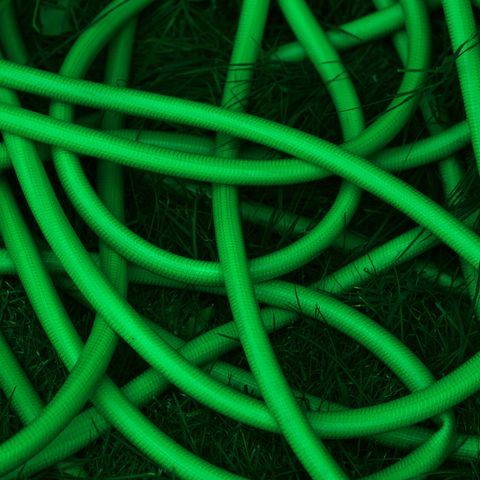
Listen, if you’re not already looking at your poop in the toilet after you do the deed, it’s time to start. You can learn a lot of crap about your health by, well, looking at your crap. (Sorry, but it’s true!)
Shape, size, and texture all matter, of course—but where peeping your poop really comes in handy is deciphering what’s up with its color. Red, for example, is usually a warning sign (unless you just had a huge meal of beets), but seeing green in the toilet (or on the paper after wiping) can make you say WTF, too.
Let’s back up a bit: Poop gets its typical brown color from a bunch of different things: yellow-green bile (made in the liver, released by the gallbladder), dead cells, gut bacteria, and of course, unused food waste, says Michael Rice, M.D., gastroenterologist at the Michigan Medicine Gastroenterology Clinic.
In most cases, seeing a tint of green in your poop is really NBD. “Green poop in itself is rarely concerning,” says Rice. But still, it’s helpful to know why your poop looks like something straight from the butt of the Grinch.
1. You’re on antibiotics.
Yes, antibiotics are great when you’re fighting off a bacterial infection—but they also kill the good bacteria in your gut, too, says Rice. Sometimes, when that happens, it can make your gastrointestinal tract work a little faster—which can change the color of your stool, he says, since those yellow-green bile pigments might not break down completely.

One way you might be able to combat this: taking probiotics. “Probiotics are live microorganisms of various strains of bacteria and yeast” that live naturally in your body already, says Rice, who adds that you can find these probiotics in foods (like kefir or yogurt), as well as supplements. Replenishing this good bacteria in your gut when it’s being wiped out by antibiotics can help your stomach maintain its status quo.
2. You switched to the birth control shot.
Depo-Provera works to suppress ovulation and has been associated with bloating or weight gain in some women, says Rice—but it’s also been known to cause some women to have green poop. “The mechanism behind this is not well understood,” says Rice, though he adds that it’s not necessarily a concern.
Still, if seeing green poop isn’t your jam, and you noticed it shortly after going on the shot, it’s worth alerting your ob-gyn to see if there’s another birth control method you can switch to.
3. You have a stomach bug.
When you have a bacterial or viral stomach illness—like norovirus, salmonella, or E.coli—your stool passes pretty quickly through your gastrointestinal tract (a.k.a., diarrhea). And in some cases, that poop can look green, again, because those bile pigments aren’t breaking down since things are moving so rapidly, says Rice.

Another condition called giardiasis—a parasitic infection often associated with drinking water contaminated with infected feces from animals or humans—can cause similar symptoms, he says.
In some cases, like with the norovirus, you just have to wait for things to resolve on their own (and make sure to drink plenty of fluids—too much diarrhea can make you dehydrated!). But if you’re experiencing fever, vomiting, dehydration, and intense abdominal pain in addition to that greenish diarrhea, see your doctor ASAP, as it could be a more serious infection and will need treatment, says Rice.
4. You’re on a salad kick.
Quick science lesson: Plants get their green color from chlorophyll—a green pigment that helps them absorb light and grow. And if you eat too many plants, that green stuff can show up in your poop, says Rice.
But it’s not just the green stuff that’s turning your stool a putrid color. “Eating lots of blue or purple foods, like blueberries, can mix with the yellow-green bile pigments and make your poop green as well,” says Rice. The same goes for blue and purple dyes in food.
TBH, there’s nothing you can really do about this, except scaling back your green veggie intake (and I’m not about that—veggies are the bomb-dot-com), so maybe just embrace your green-tinted excrement?
5. You’re taking iron supplements.
Taking iron pills orally can make your stool look black or green—but it’s important to make sure you know which color you’re dealing with (so go ahead and take peek in the toilet).

According to the U.S. National Library of Medicine, black stools are normal when taking iron supplements and may actually be a sign that your body is absorbing them correctly (though it’s important to make sure those black stools don’t look tarry or have red streaks running through them, which could signal another health issue).
Green stools, however, mean the opposite—that your body isn’t fully absorbing those nutrients—in which case, you should talk to your doctor about possibly changing to another form like intravenous (IV) iron, which won’t have the same green effect, says Rice. Though, TBH, you should be in close contact with your doc if you’re taking iron anyway, since it’s not something you should supplement with on your own.
6. You have inflammatory bowel disease or celiac disease
Crohn’s disease and ulcerative colitis, two forms of inflammatory bowel disease (IBD), cause inflammation in your gastrointestinal tract—the same goes for celiac disease (an autoimmune disease where eating gluten leads to inflammation). This inflammation, then, can cause diarrhea, which can make your poop look green due to a faster transit again (like with antibiotics and stomach illnesses).
If you have IBD or celiac, it’s important to maintain a close relationship with your doctor to help keep inflammation—and as a result, symptoms—under control, says Rice.
Source: Read Full Article
